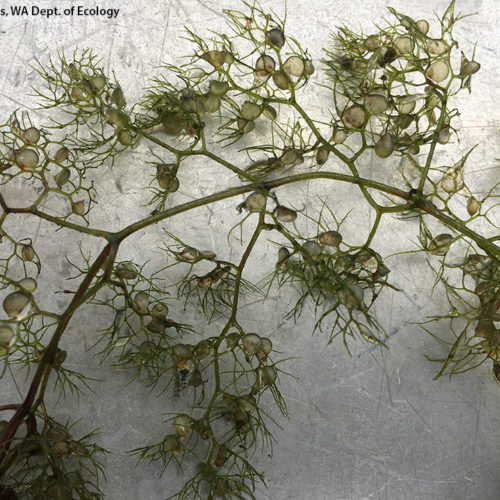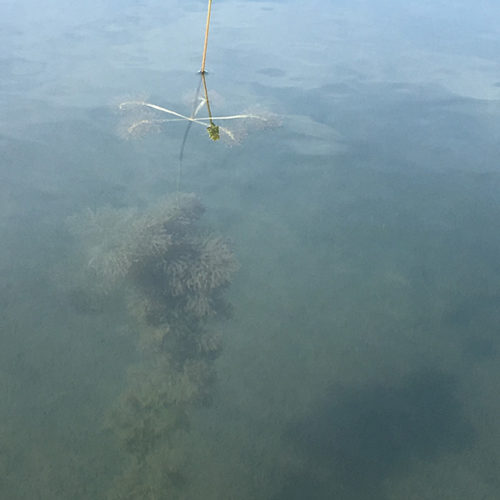Swollen Bladderwort
Utricularia inflata

Family: Lentibulariaceae
Weed class: monitor list
Year Listed: 1998
Native to: New Jersey to Florida and westward to eastern Texas and southeastern Oklahoma
Is this Weed Toxic?:
humans, livestock
Legal listings:
WAC 16-752; WSDA Quarantine list (prohibited plant list)
Why Is It a Noxious Weed?
This plant is on the monitor list - it is not a listed noxious weed in Washington. Please contact its sponsor Wesley Glisson to report locations or for more information.
How would I identify it?
General Description
Swollen bladderwort is a free-floating carnivorous plant. It has long, branched underwater stems and delicate, finely divided leaf-like stem branches. Yellow flowers are snapdragon-like and are emergent on upright stalks suspended by a spoked float. Like native bladderwort species, swollen bladderwort uses ovoid traps, or “bladders,” on its finely divided stems to capture small organisms.
Flower Description
Swollen bladderwort flowers from May to September in the Pacific Northwest. Flowers are bright yellow, to 20 mm (3/4 inch) across, and in clusters of 3 to 14 on upright stalks. The flower stalk is supported by a whorl of 5-10 spongy floating spokes measuring 3-10 cm (1 to 4 inch) long with fine divisions at the tips. The main submersed leafy part of the plant will sometimes break off from the flowering portion below the whorl of floats.
Leaf description
The leaves are very finely divided to frilly and have air bladders spread throughout. They range in size from less than 1 inch to around 7 inches.
Stem description
Bladderworts don’t have true leaves, instead they have alternate, highly branched, divided, leaf-like stems. Length of the overall branched structure ranges from 2-10 cm (3/4 to 4 in). The bladder-like traps are abundant on the branches, ovoid, stalked, and occur in two sizes of 0.7-1 mm (1/32 in) or 1.5-2 (3) mm (to 1/8 in).
Fruit Seed Description
Seed capsules are 3-6 mm (1/8-1/4 inch) across and globose with a thick, fleshy wall. Seeds are rough and globose with a diameter of ~0.75 mm.
May Be Confused With
Native species of bladderwort (Utricularia) can be viewed in the UW Herbarium's image database.
Where does it grow?
Swollen bladderwort occurs in ponds, lakes, swamps, and ditches, in shallow to deep water. In Washington, this species was first found in 1980 in Horseshoe Lake (Kitsap County). It is presently known in Kitsap, Mason, Thurston, Pierce, and Cowlitz counties.
How Does it Reproduce?
Swollen bladderwort reproduces by seed and can also reproduce asexually through fragmentation of the vegetative portion of the plant.
How Do I Control It?
Manual removal can be done, but is difficult because they will reproduce from plant fragments left behind. Draining the water and letting the plants dry and die is effective, but may not be an option in many areas. There are numerous regulations around using herbicide in aquatic areas, so reach out to a professional before considering herbicide use.
For More Information
WA Department of Ecology's Aquatic Plant Identification Manual information on swollen bladderwort
Invasive Plant Atlas of the United States
Flora of North America, Lentibulariaceae by Garrett E. Crow, 2015.
Whatcom County NWCB Fact Sheet on swollen bladderwort
Images from the UW Herbarium's image database.







